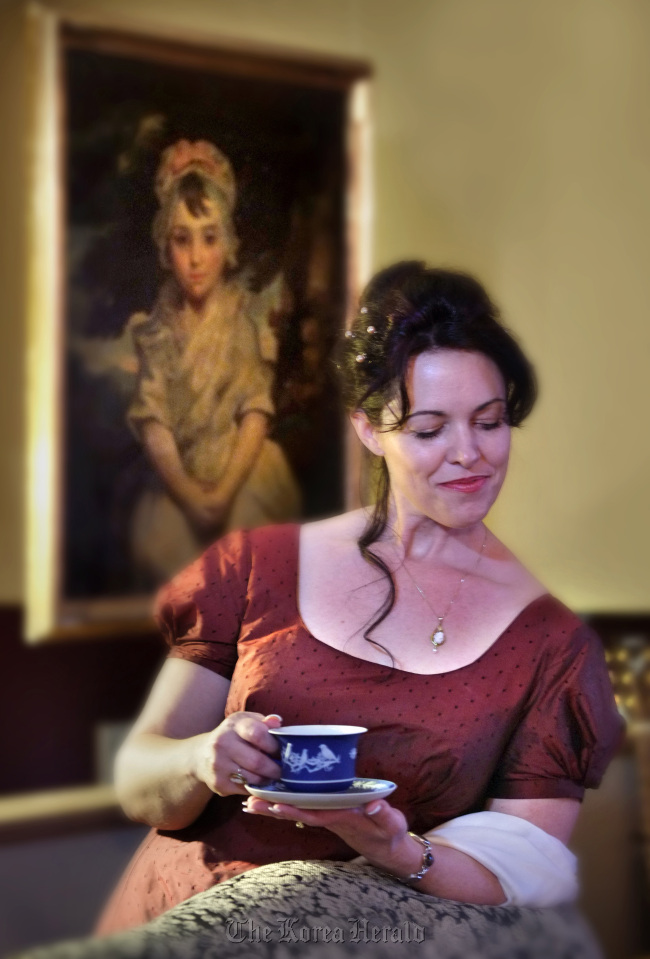MINNEAPOLIS ― “The kettle is never turned off at this house,” said Julia Matson as she set her dining-room table with Wedgwood Blue Willow cups and saucers, perfectly round scones, strawberry-rhubarb jam and clotted cream.
The aroma wafting in from the kitchen of her house in Plymouth was from her own blend of tea ― Indian, Sri Lankan and Kenyan _ brewing for precisely 4 minutes at 205 degrees. Four cups filled with loose tea leaves of different colors, shapes and textures sat at the ready for later sampling.
Matson is serious about tea. But not too serious to thoroughly enjoy every last drop.
Through her business, Bingley’s Teas, Matson sells to tea shops nationwide, from the Crown and Crumpet in San Francisco to the Blue Ox Coffee Co. in south Minneapolis. Her most popular products come from mixing her two primary passions: Jane Austen’s fiction and her favorite beverage. By assigning different blends to the immortal characters in Austen’s novels, Matson has drawn “Janeite” customers from as far away as the Middle East and Japan.
 |
Julia Matson of Plymouth, Minnesota, knows her tea. For the last 12 years she’s been studying “the leaf,” combining her passion for Jane Austen with her passion for tea, and assigning different teas to the characters in Austen’s novels. (MCT) |
The blend for Austen’s best-known creation, Elizabeth Bennet of “Pride and Prejudice,” is a black-tea base signifying her strong character, plus sassy cranberry and blue mallow for her fine eyes, tempered with sweetness. Mr. Darcy, object of Elizabeth’s scorn and ultimate affection, is an Oolong with distinctive notes of leather, chestnut and plum. Compassion for Mrs. Bennet’s Nerves is an all-herbal tisane ― chamomile, peppermint, passion flower, rosehips and lavender.
To Matson, tea and Jane go together like bonnets and shawls.
“There is an aesthetic gentleness and playfulness to the Austen world that coincides with tea,” she said. “They both bring pleasure and comfort. Both can make you laugh, bring you calm and offer insight into yourself.”
Austen, she said, bought her tea from one trusted source.
“The tea trade was shifty back in those days,” she said. “And they didn’t have tea bags, so Jane, like me, was a ‘loose’ woman.”
Matson fills her own tea filters ― usually two small ones to a pot ― rather than using pre-filled tea bags or ball infusers.
“You need to give the leaves enough room to expand, for fuller flavor,” she explained.
Matson speaks to book clubs and other groups about the history of tea, the different styles of steeping and British tea etiquette. A certified tea specialist, she has traveled across the country with the New York-based Specialty Tea Institute as well as to Taiwan. She has taken classes, studied under tea masters and visited tea producers to see how leaves are grown and processed.
“My studying will never end,” she said. “There’s always more to discover with tea.”
Matson, 42, lives with her husband, Kyle, an engineer, and their two sons. Growing up in Champaign, Ill., she was a fan of Austen’s fiction before she became engrossed in tea. After years of doing rehabilitative body work as a career, she took a community-ed class on tea ― as an excuse to bake goodies.
“I didn’t care about tea, I just wanted the shortbread and sponge cake recipes,” she said. But she soon became intrigued by “the leaf,” and decided to follow her nose and taste buds down a new path. By attending countless “cuppings” (tasting parties for tea geeks) and experimenting on her own, she learned to taste notes of naturally occurring flavors ― magnolia, chestnut, lily, burnt caramel, tobacco.
Matson’s favorite era may be the early 19th century, but that doesn’t mean her leaves aren’t hip. Eat Street Social uses her line to create tea-based cocktails. In 2011, as a sponsor of an Elvis-themed “Rock the Cause” event, Bingley’s offered Wired!, a highly caffeinated tea, and Hunka Burnin’ Love, a chocolate-chili tea with rose petals.
When Melanie Logan, owner of the Blue Ox, heard about Bingley’s Teas from a friend of Matson’s, she decided to try them at her cafe because “I like to keep things local,” she said. “Our customers love her teas ― they’re extraordinary.” But since they’re not all Austen fans, some of the names have been changed: The Patience of Miss Price has been redubbed Vanilla Dream; Marianne’s Wild Abandon is Summer Blend.
“I am literally in love with tea,” Matson said as she poured fresh cups of an odd-smelling but healthy matcha, green and frothy. “I have such a crush on it, and I don’t seem to be getting over it.”
This declaration didn’t faze her husband, who had just arrived home from work and made a beeline for the scones.
During Austen’s time, the Regency era, tea was expensive, but nonetheless an important social ritual, Matson said.
“You knew you were someone if you were invited to take tea. It was also frequently served after dinner, which no one seems to want to do these days for fear of caffeine.”
Matson’s modern-day tea parties replicate that social purpose, but hers “are as bawdy as they are proper,” she said, laughing. “You can go really deep with both Jane and tea, but it’s helpful not to be too serious. Enjoy them, share them and find others who like to do the same. It builds community when we discuss things over a cuppa. Tea is not hard. Make it the way you like, and all the other stuff is for fun.”
By Kristin Tillotson
(Star Tribune)







![[Today’s K-pop] Blackpink’s Jennie, Lisa invited to Coachella as solo acts](http://res.heraldm.com/phpwas/restmb_idxmake.php?idx=644&simg=/content/image/2024/11/21/20241121050099_0.jpg)
